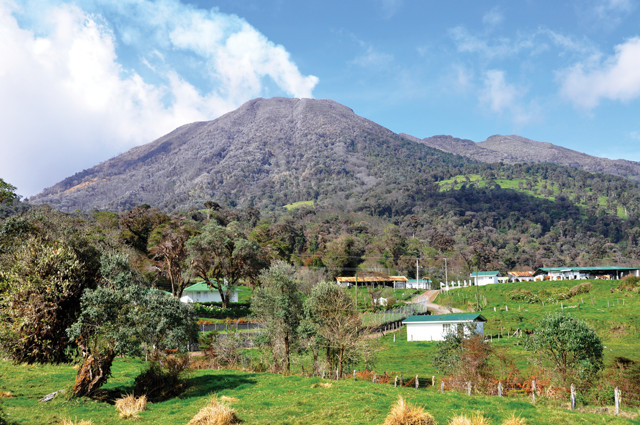
by Mary Caperton Morton Thursday, August 10, 2017

Turrialba Volcano in Costa Rica showed an increase in sulfur dioxide emissions after earthquakes. Credit: ©iStockphoto.com/piratedub.
Triggering of volcanic emissions by earthquakes has been observed since antiquity. The Roman naturalist and philosopher Pliny the Elder proposed the link as early as A.D. 77, and in “The Voyage of the Beagle,” Charles Darwin wrote about inland eruptions in Chile closely following an offshore earthquake in 1835. More recent statistical studies show that after large earthquakes, volcanic activity around the world increases. But the lack of robust monitoring equipment at most volcanoes has made it hard to quantify the relationship. In a new study, scientists demonstrate how satellites can be used to track changes in sulfur dioxide emissions from volcanoes after seismic events, offering a potential way to study the often elusive link between seismicity and volcanism.
Sometimes, earthquakes trigger full-scale volcanic eruptions, but that isn’t always the case, says Greg Waite, a seismologist at Michigan Tech University and an author of the new study, published in Geology. More often, passing seismic waves set off more subtle changes in activity, such as an uptick in sulfur dioxide gas emissions. “When you only look at triggered full-blown eruptions, the dataset is pretty small, which makes it difficult to draw conclusions about the relationships between earthquakes and volcanism,” he says.
To study the effects of earthquake activity on sulfur dioxide emissions, lead investigator Dulcinea Avouris, now at Kent State University in Ohio, combined data from the Ozone Monitoring Instrument on NASA’s Aura satellite with surface seismic wave data from a catalog of 69 earthquakes that occurred between 2004 and 2010. The team focused on activity at 12 active volcanoes — including Bagana, Rabaul and Ulawun in Papua New Guinea; Turrialba in Costa Rica; and Villarrica in Chile — with good data coverage that exhibited a range of eruptive styles, from lava lakes to dome growth to open-vent degassing. They tracked the changes in sulfur dioxide emissions for month-long windows before and after the earthquakes.
They found two distinct volcanic responses: a positive response when the post-earthquake sulfur dioxide emissions increased by more than 20 percent (positive responses with emissions increases of less than 20 percent were not counted); and, somewhat unexpectedly, a negative response when sulfur dioxide emissions decreased significantly after an earthquake, called triggered quiescence. “We were surprised to get such a good record of the negative response,” Waite says.
Triggered quiescence has been speculated about but rarely observed, says Emily Brodsky, a seismologist at the University of California, Santa Cruz, who was not involved in the new study. “Negative responses have not been well documented. It’s always easier to identify an increase in activity than a decrease,” Brodsky says. “You really need these kinds of long-term gas records to demonstrate that there is a link between seismic waves and triggered quiescence.”
The positive and negative responses correlated strongly with the volcanoes' eruptive style, with open-vent, basaltic volcanoes exhibiting positive responses and andesitic volcanoes with plugged conduits exhibiting negative responses. The positive responses may be caused by mobilization of gas bubbles in the magma system, while drops in sulfur dioxide emissions may be tied to decreases in permeability in magma systems, temporarily reducing the amount of gas that can escape, Waite says.
Interestingly, increases in sulfur dioxide emissions seemed to lag behind the triggering earthquakes by several days, Waite says. “The delay didn’t appear to depend on the volcano’s distance from the source of the earthquake, nor did it seem to be related to the size of the shaking.” Instead, the delay is likely caused by factors internal to the volcano itself, as a cascade of events leads to the uptick in activity, he says. No clear timing trend was observed for the decreases in sulfur dioxide activity.
Brodsky says she expects to see more of these kinds of gas studies in the next few years. “Continuous gas monitoring is one of the most exciting things happening in volcanology. It really opens the door to more systematic comparisons between volcanic systems,” she says. “There are all sorts of good physical reasons to believe that gas emissions should react to distant earthquakes, but to actually see it clearly demonstrated is very exciting.”
© 2008-2021. All rights reserved. Any copying, redistribution or retransmission of any of the contents of this service without the expressed written permission of the American Geosciences Institute is expressly prohibited. Click here for all copyright requests.